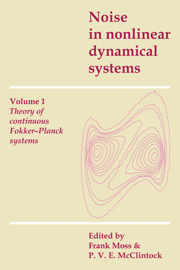Book contents
- Frontmatter
- Contents
- List of contributors
- Preface
- Introduction to Volume 1
- 1 Noise-activated escape from metastable states: an historical view
- 2 Some Markov methods in the theory of stochastic processes in nonlinear dynamical systems
- 3 Langevin equations with colored noise
- 4 First passage time problems for non-Markovian processes
- 5 The projection approach to the Fokker–Planck equation: applications to phenomenological stochastic equations with colored noises
- 6 Methods for solving Fokker–Planck equations with applications to bistable and periodic potentials
- 7 Macroscopic potentials, bifurcations and noise in dissipative systems
- 8 Transition phenomena in multidimensional systems – models of evolution
- 9 Colored noise in continuous dynamical systems: a functional calculus approach
- Appendix: On the statistical treatment of dynamical systems
- Index
7 - Macroscopic potentials, bifurcations and noise in dissipative systems
Published online by Cambridge University Press: 05 January 2012
- Frontmatter
- Contents
- List of contributors
- Preface
- Introduction to Volume 1
- 1 Noise-activated escape from metastable states: an historical view
- 2 Some Markov methods in the theory of stochastic processes in nonlinear dynamical systems
- 3 Langevin equations with colored noise
- 4 First passage time problems for non-Markovian processes
- 5 The projection approach to the Fokker–Planck equation: applications to phenomenological stochastic equations with colored noises
- 6 Methods for solving Fokker–Planck equations with applications to bistable and periodic potentials
- 7 Macroscopic potentials, bifurcations and noise in dissipative systems
- 8 Transition phenomena in multidimensional systems – models of evolution
- 9 Colored noise in continuous dynamical systems: a functional calculus approach
- Appendix: On the statistical treatment of dynamical systems
- Index
Summary
Introduction
The two most prominent branches of macroscopic physics, reversible classical mechanics and reversible equilibrium thermodynamics, are both characterized by extremum principles – the principle of stationary action for a classical trajectory, and the principle of maximum entropy for thermodynamic equilibrium in a closed system. It is well known how both of these extremum principles arise by taking the macroscopic limit of more fundamental underlying microscopic theories, in which these extremum principles do not hold: quantum mechanics and statistical mechanics, respectively. In these microscopic theories the extremum principles are violated by the occurrence of fluctuations; quantum fluctuations by which finite probability amplitudes are assigned to nonclassical trajectories, and classical fluctuations which assign nonzero probabilities to states with less than the maximum entropy. Hence, there is a deep connection in physics between fluctuation phenomena and extremum principles, the former providing a mechanism allowing the system to explore a neighbourhood of the extremizing state and thereby to identify the extremum.
The last decade has seen a considerable increase of interest in non-equilibrium phenomena in macroscopic systems, as it was realized that simple and rather general mechanisms of self-organization exist in such systems (cf., e.g. Haken, 1977, 1983; Nicolis and Prigogine, 1977), leading to the selection, formation and competition of patterns in space and (or) time. The evolution equations governing these nonequilibrium phenomena neither belong to the realm of equilibrium thermodynamics, therefore thermodynamic extremum principles are not applicable, nor to the realm of reversible classical mechanics covered by the principle of least action.
- Type
- Chapter
- Information
- Noise in Nonlinear Dynamical Systems , pp. 225 - 278Publisher: Cambridge University PressPrint publication year: 1989
- 34
- Cited by



